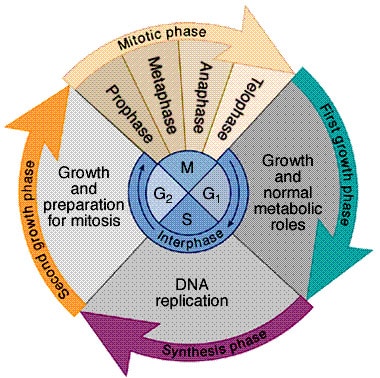Cell Cycles Interphase Mitosis Cytokinesis Biology Diagrams In the eukaryotic cell cycle, chromosome duplication occurs during "S phase" (the phase of DNA synthesis) and chromosome segregation occurs during "M phase" (the mitosis phase). During S phase The S (synthesis) phase of the cell cycle occurs when genomic DNA within the nucleus is replicated. Numerous proteins and enzymes are involved in the transition from G1 to S phase before DNA replication. Upon S phase initiation, double-stranded DNA is unwound and separated parental strands act as a template to synthesize complementary daughter The S phase is important because of what takes place during this portion of the cell cycle and also because of what it represents. Entering S phase (passing through the G1/S transition) is a major checkpoint in the cell cycle, sometimes called the restriction point.

The most basic function of the cell cycle is to duplicate accurately the vast amount of DNA in the chromosomes and then segregate the copies precisely into two genetically identical daughter cells. These processes define the two major phases of the cell cycle. DNA duplication occurs during S phase (S for synthesis), which requires 10-12 hours and occupies about half of the cell-cycle time in S phase (Synthesis phase) is the phase of the cell cycle in which DNA is replicated, occurring between G 1 phase and G 2 phase. [1] Since accurate duplication of the genome is critical to successful cell division, the processes that occur during S-phase are tightly regulated and widely conserved. The somatic eukaryotic cell cycle is a series of phases: G1, S, G2, and mitosis. Cells start the cell cycle in G1 (gap phase 1) progress through S (DNA replication), G2 (gap phase 2), and then divide in M (mitosis) . Cells enter G1 either from the preceding mitosis and cytokinesis or from a quiescent state (also known as G0 phase) which is

Preparation for DNA Replication: The Key to a Successful S phase Biology Diagrams
S phase DNA replication is a crucial process in the cell cycle where DNA is duplicated, preparing the cell for division. It involves the unwinding of the DNA double helix, the synthesis of new DNA strands complementary to the existing ones, and the formation of new DNA molecules. Two main structures, the helicase enzyme and the replication fork, play key roles in this process. Therefore, at the end of the S phase, each chromosome of the cell has double the amount of DNA with a double set of genes. 4. Gap 2 Phase (G2) The G2 phase or Gap Phase 2 or Growth Phase 2 is a phase of the cell cycle where the cell collects nutrients and releases proteins in order to prepare the cell for the M phase. Learn what occurs in the S phase of interphase, when DNA is replicated before cell division. Find out how the S phase is regulated by checkpoints, proteins, and enzymes, and why it is important for cell growth and reproduction.
